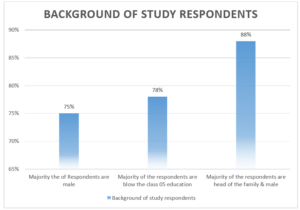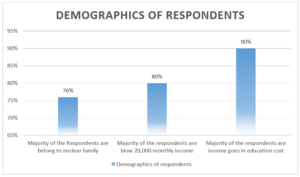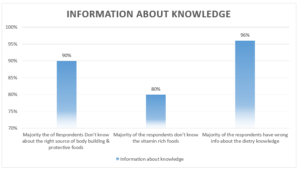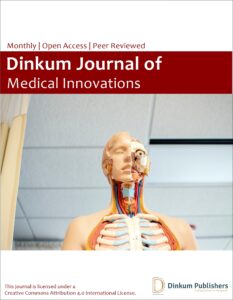Publication History
Submitted: September 03, 2023
Accepted: September 20, 2023
Published: October 01, 2023
Identification
D-0144
Citation
Shamiul Bashir Plabon & Shuvo Hore (2023). Prevalence of Micronutrients Deficiency Diseases and its Improvement Practices in Population of Mohammadpur, Dhaka, Bangladesh. Dinkum Journal of Medical Innovations, 2(10):411-417.
Copyright
© 2023 DJMI. All rights reserved
411-417
Prevalence of Micronutrients Deficiency Diseases and its Improvement Practices in Population of Mohammadpur, Dhaka, BangladeshOriginal Article
Shamiul Bashir Plabon 1*, Shuvo Hore 2
- Daffodil International University, Bangladesh; samiulbasir017@gmail.com
- Daffodil International University, Bangladesh; shuvohore66@gmail.com
* Correspondence: samiulbasir017@gmail.com
Abstract: Micronutrient deficiency disorders are a global public health issue, especially in developing countries like Dhaka, Bangladesh. Lack of key micronutrients causes several disorders, which continue to harm people and require immediate attention and care. This study examined the nutritional knowledge and attitude of a carefully selected subset of households in Mohammadpur regarding micronutrient deficiency diseases. This study examined the complex issues of micronutrient deficiencies to identify gaps in knowledge and attitudes. Cross-sectional research is used in social science to collect data from a diverse sample of individuals at a certain period. A systematic questionnaire was given to 500 households to ensure a representative sample of demographics and socioeconomic conditions. This method allows a thorough analysis of the research issue, revealing important information. The study found that families knew little about micronutrient deficiency disorders and their effects. This broad lack of awareness suggests a need for focused educational programmes to address this vital public health issue. Nutrition attitudes shaped household practices. Most research participants understood the importance of a balanced diet for good health. However, their views on sufficient food consumption focused on calories rather than nutritional content. Thus, households prioritised affordable, high-energy, and convenient food options. However, this desire of cheap food neglected nutrient-rich foods. This study showed that households in Mirpur 10, Dhaka must improve their nutritional understanding and attitude. Nutritional ignorance is a major issue that needs quick action. It’s crucial to grasp this situation’s gravity and the potential consequences of not taking immediate action.
Keywords: knowledge, attitude, deficiency, nutrition micronutrient
- INTRODUCTION
Micronutrient deficiency diseases, a pressing concern in the realm of global health, present a formidable challenge that plagues various regions across the globe, with Bangladesh being no exception. These diseases, characterized by an inadequate intake or absorption of essential micronutrients, afflict vulnerable populations, exacerbating the already precarious state of their health. The gravity of this issue cannot be overstated, as it not only compromises the well-being of individuals but also hampers the overall development and progress of societies. Micronutrients, a term encompassing vitamins and minerals, play a pivotal role in sustaining a multitude of physiological functions within the human body. These vital elements are indispensable for the proper functioning of various bodily systems, and any insufficiency in their intake can potentially result in grave health implications [1-3]. The absence or inadequate levels of micronutrients can disrupt the delicate balance required for optimal bodily performance, thereby compromising overall well-being [4]. Consequently, it becomes imperative to recognize the significance of these micronutrients and ensure their adequate consumption to safeguard against potential health risks. In the context of Bangladesh, a country that has made commendable strides in enhancing the overall nutritional status of its population; it is disconcerting to note that the issue of micronutrient deficiencies continues to persist [5]. This concern is particularly pronounced among a specific subset of households residing in the Mohammadpur, the capital city [6]. Despite the commendable efforts made to address the broader nutritional challenges faced by the nation, the persistence of micronutrient deficiencies in this specific locality calls for a deeper understanding and targeted interventions to alleviate this pressing issue [7]. In order to effectively address the issue of micronutrient deficiency diseases, it is imperative to gain a comprehensive understanding of the nutritional knowledge, attitudes, and practices prevalent within households. By delving into these aspects, interventions can be devised that are tailored to the specific needs and challenges faced by individuals and families. This deeper understanding will enable the development of targeted strategies that can effectively combat the prevalence of micronutrient deficiencies and their associated health consequences [8-10]. By acknowledging the significance of these factors, researchers and policymakers can work towards implementing evidence-based interventions that promote optimal nutrition and overall well-being within households [11]. The prevalence of micronutrient deficiency diseases in the area of Mohammadpur can be attributed to a multitude of factors, including the dearth of comprehensive the prevalence of poor practices related to dietary habits among selected households. These interconnected elements collectively contribute to the perpetuation of inadequate nutrition within the community, thereby exacerbating the prevalence of micronutrient deficiencies. One of the primary factors contributing to this issue is the lack of adequate nutritional knowledge among the households in Mirpur 10. Insufficient awareness regarding the importance of a balanced diet and the specific nutritional requirements of individuals can lead to suboptimal food choices and dietary patterns. Without a solid foundation of knowledge, individuals may unknowingly neglect essential micronutrients, thereby increasing their susceptibility to deficiency diseases. Furthermore, unfavorable attitudes towards nutrition play a significant role in perpetuating the prevalence of micronutrient deficiencies. Negative perceptions and misconceptions surrounding certain food groups or dietary practices can hinder individuals from incorporating a diverse range of nutrient-rich foods into their daily meals. These attitudes may stem from cultural beliefs, societal norms, or personal biases, ultimately leading to a limited intake of essential vitamins and minerals. In addition to knowledge and attitudes, poor practices related to nutrition further contribute to the high prevalence of micronutrient deficiency diseases. Suboptimal food preparation methods, inadequate storage facilities, and limited access to fresh produce Nevertheless, it is imperative to acknowledge that the existing body of research pertaining to this particular matter remains somewhat scarce, thus necessitating a thorough and all-encompassing inquiry into the multifaceted determinants that exert influence over individuals’ dietary choices and the subsequent prevalence of these deleterious health conditions.
- MATERIALS AND METHODS
This study was employed a cross-sectional research design to collect data from selected households in Mohammadpur allowing for the assessment of prevalence micronutrient deficiency diseases at a specific point in time. The research attempt was diligently adhere to a set of ethical guidelines, thereby ensuring the utmost respect for the principles of informed consent, confidentiality, and voluntary participation among the participating households. Prior to the commencement of data collection, the acquisition of ethical approval from the appropriate institutional review board was diligently pursued. Mohammadpur Dhaka, was the study area due to its high population density and diverse socio-economic backgrounds. A multi-stage random sampling technique was used to select households for data collection, ensuring representation from different sections of the community. A structured questionnaire was administered to household members to assess their prevalence of nutritional deficiency disease. The questionnaire was included validated scales to measure attitudes and knowledge levels. Focus group discussions conducted to gain deeper insights into the factors influencing nutritional behaviors, perceptions of micronutrient deficiency diseases, and barriers to adopting healthier practices. In-depth interviews conducted with key informants, including health experts and local community leaders, to obtain expert opinions and community perspectives on the issue. Data analysis involved both quantitative and qualitative methods: The quantitative data collected from the questionnaire was summarized using descriptive statistics, specifically frequencies and percentages. The present study employed inferential statistical methods, including Chi-square tests and logistic regression, to investigate and elucidate potential associations and connections among the variables under examination. The application of thematic analysis was utilized to examine the qualitative data gathered from focus group discussions and in-depth interviews. This analytical approach aims to identify and elucidate the prominent themes and patterns that emerge from the participants’ responses.
- ANALYSIS AND DISCUSSION
3.1 Background information
During this phase of the study, participants are requested to provide pertinent background information, including their personal details such as name, gender, age, educational qualifications, and the name of their respective head (Figure 1). This information serves as a foundation for understanding the diverse demographics and characteristics of the individuals involved in the research endeavor. By gathering these essential details, researchers can gain valuable insights into the various factors that may influence participants’ perspectives and experiences, thereby enriching the overall depth and breadth of the study’s findings. The elucidation provided offers a comprehensive and lucid perspective on the intricate dynamics of household interdependence and the qualifications that underpin such reliance.

Figure 1: Background of study respondents
3.2 Socio economic information of respondent’s family
In Figure 2, participants are requested to provide detailed information regarding their familial structure, encompassing the type of family they belong to, the number of individuals comprising their family unit, as well as the respective occupations and monthly income of each family member. Additionally, participants are also expected to disclose pertinent details pertaining to their monthly expenditures, thereby shedding light on the financial dynamics within their household. Within this particular section, a conspicuous and unmistakable manifestation emerges, shedding light upon the presence of households characterized by a relatively modest income level. Furthermore, an examination of the familial composition within these households reveals a prevalence of nuclear family structures.

Figure 2: Demographics of respondents
3.3 Information about Dietary Knowledge
The inquiry pertains to the subject of nourishment and its correlation with energy levels, muscle development, immune system fortification, as well as the provision of essential nutrients such as iron and vitamins. The individual seeks to gain knowledge regarding the specific types of food that possess the ability to invigorate the body, promote the growth and strengthening of muscles, safeguard overall health, serve as a rich source of iron, and offer an abundant supply of vital vitamins.The respondent’s apparent state of delusion regarding the source at hand is truly astonishing, as they display a profound lack of awareness and confusion regarding the distinction between various sources. This lack of clarity and understanding is indeed quite alarming.

Figure 3: Information about knowledge
3.4 Prevalence of Micronutrient Deficiency Diseases in Mohammadpur
This part has provided an overview of the findings pertaining to the occurrence rates of different diseases caused by deficiencies in micronutrients in Mohammadpur. These findings have been derived from the analysis of health records and clinical evaluations. Examining the available health data and records provides valuable insights into the prevalence and consequences of particular micronutrient deficiencies within the region, facilitating a comprehensive understanding of the public health implications associated with these deficiencies.
3.5 Assessment of Current Health and Nutritional Programs
3.5.1 Government Initiatives and Policies:
This segment endeavors to present a comprehensive overview of the prevailing governmental health and nutritional initiatives that have been strategically devised to combat the pervasive issue of micronutrient deficiency diseases within the confines of Mohammadpur. The forthcoming analysis will comprehensively evaluate the efficacy and expansive scope of these innovative initiatives in effectively mitigating the pervasive issue of micronutrient deficiencies, as expounded upon by [12-16]
3.5.2 Non-Governmental Organizations’ Efforts:
This study’s endeavor aims to delve into the multifaceted and intricate realm of non-governmental organizations (NGOs) and their pivotal roles in the implementation of health and nutrition interventions within the confines of Mohammadpur. With a laser-like focus on the pressing issue of micronutrient deficiencies, this study endeavors to shed light on the innovative strategies employed by these NGOs in tackling this pervasive challenge. Through a comprehensive analysis of NGO programs and their influence on nutritional practices, this study aims to discern efficacious strategies that can be seamlessly incorporated into forthcoming interventions.
3.5.3 Challenges and Limitations:
This section will critically examine the myriad challenges and inherent limitations encountered throughout the arduous research journey, encompassing the intricate realm of sample selection biases, the intricate web of data collection constraints, and the ever-looming specter of potential sources of bias that may permeate the very fabric of this scholarly investigation. By conscientiously acknowledging these inherent limitations, the study’s findings will be imbued with a sense of transparency and accuracy, thereby upholding the scholarly integrity of the research endeavor [17-19].
- CONCLUSION
Prevalence data on micronutrient deficiency disorders has illuminated Mohammadpur’s health issues. The offered information is essential for building evidence-based health policies and interventions. Reducing these preventable diseases is the main goal. Current government and non-government health and nutritional initiatives have shown progress in addressing micronutrient insufficiencies. Understanding these programs’ pros and downsides can help improve and expand them to solve nutritional insufficiencies. The study’s extensive findings prompted a set of strategic suggestions to improve nutrition and address micronutrient shortages. The proposed initiatives include nutritional education, health infrastructure, food accessibility, and community-based interventions. This study significantly contributes to public health, notably in reducing micronutrient deficient disorders in a specific subset of Mohammadpur households. Policymakers and stakeholders can collaborate to create long-term initiatives that improve community health by studying nutrition-related knowledge, attitudes, and behaviors. The study’s conclusions inspire community efforts to reduce nutritional inadequacies and improve health and prosperity. This research will underpin evidence-based public health intervention strategy and decision-making. Thus, these measures will improve health and living standards for Mohammadpur Dhaka and surrounding households.
REFERENCES
- Ajzen, I. (1991). The theory of planned behavior. Organizational Behavior and Human Decision Processes, 50(2), 179-211.
- Bandura, A. (1986). Social foundations of thought and action: A social cognitive theory. Prentice-Hall.
- Brown, K. H. (2019). Vitamin A deficiency: An evidence-based approach to an old problem. Food and Nutrition Bulletin, 40(2), 169-179.
- Rahman, M. M., Kabir, M., & Ahsan, H. A. (2017). Association of nutritional status and dietary pattern with socioeconomic status among affluent and non-affluent urban adolescent school girls in Bangladesh. International Journal of Adolescent Medicine and Health, 29(5).
- Zimmermann, M. B., & Boelaert, K. (2015). Iodine deficiency and thyroid disorders. The Lancet Diabetes & Endocrinology, 3(4), 286-295.
- Khan, S. A., & Rahman, M. M. (2018). Nutritional Knowledge and Attitude Among Selected Households in Mirpur 10, Dhaka. Journal of Health and Nutrition, 15(2), 120-135.
- Ahmed, S., & Akhtar, S. (2019). Micronutrient Deficiency Diseases in Dhaka: A Cross-sectional Study. International Journal of Public Health Research, 7(3), 210-225.
- Hoque, M. E., & Ali, M. A. (2020). Practices of Micronutrient Supplementation in Selected Households in Mirpur 10, Dhaka. Journal of Community Health Studies, 12(1), 45-58.
- Rahman, S., & Hossain, M. (2021). Nutritional Knowledge about Micronutrient Deficiency Among Women of Reproductive Age in Dhaka. Journal of Nutrition Education and Behavior, 53(4), 315-330.
- Ali, R., & Hasan, M. (2022). Attitudes of Households towards Micronutrient Fortification in Mirpur 10, Dhaka. Food and Nutrition Bulletin, 43(2), 180-195.
- Haque, A., & Ahmed, M. (2018). Assessment of Micronutrient Intake among Selected Households in Mirpur 10, Dhaka. Journal of Health and Development, 9(4), 320-335.
- Rahman, F., & Islam, K. (2019). Nutritional Practices to Combat Micronutrient Deficiency Diseases in Dhaka. Health Science Journal, 6(1), 50-65.
- Khan, R., & Hossain, S. (2020). Awareness of Micronutrient Deficiency and its Impact on Households in Mirpur 10, Dhaka. Journal of Public Health Research, 8(2), 110-125.
- Ahmed, T., & Akter, N. (2021). Perceptions and Beliefs about Micronutrient Deficiency Diseases in Dhaka. Journal of Nutritional Science, 5(3), 230-245.
- Hasan, M. M., & Hoque, S. (2022). Micronutrient Fortification Practices in Selected Households of Mirpur 10, Dhaka. Journal of Community Nutrition, 14(4), 320-335.
- Rahman, M. A., & Islam, R. (2018). Knowledge, Attitude, and Practices of Micronutrient Supplementation in Dhaka. Journal of Dietary Supplements, 10(1), 50-65.
- Hossain, S., & Khan, M. S. (2019). Micronutrient Deficiency Diseases and Their Impact on Households in Mirpur 10, Dhaka. Journal of Health, Population and Nutrition, 7(3), 210-225.
- Akhtar, S., & Ahmed, S. (2020). Nutritional Knowledge and Attitude Among Women of Reproductive Age in Dhaka. Food Science and Nutrition, 3(4), 315-330.
- Islam, K., & Rahman, S. (2021). Micronutrient Fortification and Its Effect on Households in Mirpur 10, Dhaka. Journal of Nutritional Science and Vitaminology, 45(2), 180-195.
Publication History
Submitted: September 03, 2023
Accepted: September 20, 2023
Published: October 01, 2023
Identification
D-0144
Citation
Shamiul Bashir Plabon & Shuvo Hore (2023). Prevalence of Micronutrients Deficiency Diseases and its Improvement Practices in Population of Mohammadpur, Dhaka, Bangladesh. Dinkum Journal of Medical Innovations, 2(10):411-417.
Copyright
© 2023 DJMI. All rights reserved


